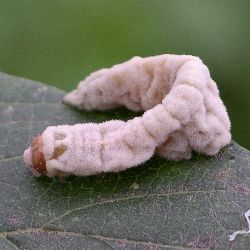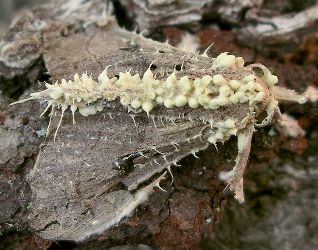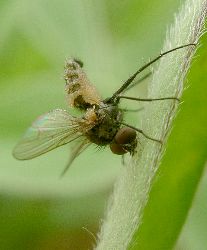 caterpillar covered in fresh spores |  moth completely encased by fungus |  fly bursting with spores |
I took photos and later, with the help of that exceptional tool for studying minutia, the computer monitor, I saw the detail of the white objects. It turned out that the fungus hypothesis was correct and some of the released white spores had clumped onto the sparse hair-like spines of the larva, forming roughly spindle-shaped globs.
 caterpillar covered in fresh spores |  moth completely encased by fungus |  fly bursting with spores |
Many people are not aware that insects suffer from some of the same kinds of pathogens that afflict vertebrates. Viruses, bacteria, and fungi have all evolved species that attack insects. We are fortunate that many of the microscopic organisms infecting us do no more harm than make us rather miserable for a week or so before we fight off the attack and return to normal health. In the bug-eat-bug world of small arthropods, though, even a slight malady can prove fatal because it decreases the host's chance of evading predators or finding food. And it seems that many of the disease causing organisms in insects are not even slightly benign.
 cuckoo bee killed by fungus |
Because the spores of fungi are microscopic and generally float about in the air, they can travel long distances and be found just about anywhere. An infection begins when the spores contact an appropriate host insect and stick to its exoskeleton. A spore germinates and produces hyphae that penetrate into the insect's body. The main part of the fungus, the mycelium, often grows throughout the body, sometimes producing toxins that kill the host relatively quickly, as in the case of the caterpillar we found. Once the insect is dead, the spores are released into the air and the cycle starts again.
In other cases, the growth takes more time and the fungus actually invades the nervous system, causing the insect to act in an unusual way. Ants and other hymenoptera can sometimes be found with their jaws clamped to the tips of branches or leaves. While some bees and wasps actually sleep in this position, a more sinister cause can be a fungus that forces the host to climb upwards to where the resulting spores will have a better chance of being dispersed into the air.
One of the most common examples of fungal death can be seen in flies. Not only does the fungus make the fly perch well above the ground, but it also forces the insect to spread its wings before dying, thus assuring that they will not impede dispersal when the spores burst forth from between the fly's body segments.
Since insects are the most numerous and diverse group of animals on the planet, it logically follows that there are myriad other organisms that have evolved to take advantage of this bounty. It is also no surprise that there are many ways that such a prolific group is kept in check rather than reproducing to the point of exhausting resources. Though some types of insect mortality are rather gruesome or repulsive to our sensibilities, it's pretty easy to keep things in perspective. Remember, they are just bugs.